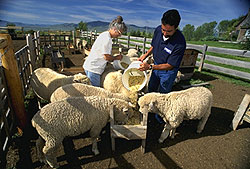|
|
 |
PAGE 52 / 87 |
 |
Unit 2: Marketing Opportunities and Strategies for Sustainable Farm/Ranch Businesses
 |
(USDA) |
As mentioned in other places in this course, working with farmers and ranchers on their business and marketing plans means becoming a co-learner. Go with the farmer when they visit with buyers or work alongside them as they conduct their market research. Or consider hosting a “speed dating” workshop to connect local buyers with farmers and ranchers, like those described here:
Marketing & Sales Series: Pt 12 ~ ‘Speed Dating’ Connects Farmers and Schools and Using Speed Dating Techniques to Enliven and Improve Conferences and Workshops.
Other ways to help: offer to assist with simple consumer surveys or with sales projections. Put farmers and ranchers in touch with marketing organizations and other resources that can help with the development of test products, consumer focus groups and marketing plans. Grant opportunities are available to assist with this type of formal research (like those mentioned in Unit 1).
Secondary research refers to the use of secondary sources of information. Instead of gathering information themselves, producers review data from other sources such as research reports, journal articles, and information from the news media. Topics might include household spending, consumer preferences, purchasing trends, predicted sales, and others. While these resources offer reliable information about the consumption of conventional commodities or more traditional target markets, it may be difficult to find information specifically about innovative or value-added marketing. Extension educators and other agricultural advisors have a key role to play in assisting farmers and ranchers with secondary research. |